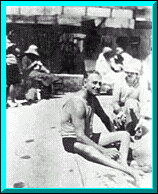Polio changed FDR. He had had a life of unparalleled
success until then. He was an only son and his mother adored him, showered him with
attention. He had always been given anything he wanted. And then he got polio.
Polio was the only thing that he had ever confronted that he couldn't beat.
He had decided, 'I'm going to lick this, I'm going to walk again.' And seven years
of his life were devoted entirely to rehabilitation. And he didn't win. He was
no more rehabilitated at the end of seven years than he was at the beginning.
Hugh Gallagher
polio survivor
biographer of Franklin Roosevelt
quoted in A Paralyzing Fear
Page 1 | Page 2 | Page 3
Franklin Delano Roosevelt was only 25 when he began to tell his friends
that he wanted to be president. Three years later, in 1910, he ran for state
assemblyman for Dutchess County, New York. Although this was traditionally a
republican district, and Roosevelt was a democrat, he won. He was re-elected in
1912.
In that same year, Roosevelt supported Woodrow Wilson at the Democratic
national convention. As a reward for his support, Wilson appointed him Assistant
Secretary of the Navy, a position he held until 1920. In 1920, Roosevelt was named
vice presidential candidate on James Cox's democratic ticket. Warren Harding won,
however, and Roosevelt went to New York, where he became vice president of the local
office of the Fidelity and Deposit Company of Maryland and partner in the law firm of
Emmet, Marvin, and Roosevelt. In both places, his primary purpose was to be a famous
face that would attract business to the company.1
In the summer of 1921, Roosevelt was facing a Senate inquiry into abuses
perpetuated by a secret vice squad that he had authorized while assistant secretary to the
Navy. Roosevelt left Washington in fury to attend a Boy Scout rally on the Hudson
River in New York.2 From there he went to Campobello
Island, an island retreat that lies off the Canadian coast.
On 10 August, Roosevelt was thirty-nine years old. He had spent the
day swimming in the Atlantic and had returned to shore to help fight a forest fire.
He then read the mail while still wearing his wet bathing suit. Chilled, he
took to his bed. The next morning his right knee felt weak. That evening it
gave way. By the following evening, he could not walk; he never walked alone again.3
Roosevelt spent the next seven years trying to regain the use of his
legs. In 1924, as part of his efforts, he visited a thermal spa in Georgia called
Warm Springs. He devised a series of exercises, which he performed in the natural
baths. Although this did not help his legs, it did make him feel better, and it
built up strength in his other muscles. In 1926, Roosevelt spent over half of his
personal fortune to buy Warm Springs.

Roosevelt relaxes poolside
at Warm Springs
Photo courtesy of the
New Deal Foundation
Drawn by a name that was kept in the public eye, wealthy polio patients
flocked to Warm Springs. They created a community where no one felt ashamed to be
paralyzed. Warm Springs gave them strength, both physically and emotionally.
In 1928, Roosevelt ran for governor of New York. He applied for an
insurance policy that required a full physical to dispel rumours that he was too weak to
serve. The doctors' reports were released to the media, and the public learned that
Roosevelt was almost totally paralyzed in his legs, but in otherwise excellent health.4
Roosevelt's political life was carefully co÷rdinated. He never
appeared paralyzed. Whenever he was in public, he would lock his leg braces at the
knees, so that his legs would not collapse. He would lean on canes or someone's arm.
He never allowed himself to be photographed by the media in a wheelchair or while
he was being carried. When he was photographed, he was shown sitting behind a desk
or in a car, or leaning against a railing as he delivered an speech with eloquence and
passion. He even painted his crutches to match his socks.5
The media co÷perated. Only two known photographs exist of Roosevelt in his
wheelchair.6
Page 1 | Page 2 | Page 3


Footnotes
1. Smith, Jane S. Patenting the Sun: Polio and the
Salk Vaccine. New York, New York: William Morrow and Company, Inc.
1990. p. 47.
2. idem. p. 45.
3. Seavey, Nina Gilden, Jane S. Smith, & Paul
Wagner. A Paralyzing Fear: The Triumph over Polio in America. New
York, New York: TV Books. 1998. pp. 46-47.
4. idem. p. 49.
5. Brown, Randy. "Freedom From Fear." Building
OnLine. http://www.buildings.com/smarter/Freedom.html.
(31 May 1999).
6. Seavey, Nina Gilden, Jane S. Smith, & Paul
Wagner. A Paralyzing Fear: The Triumph over Polio in America. p. 50. |
